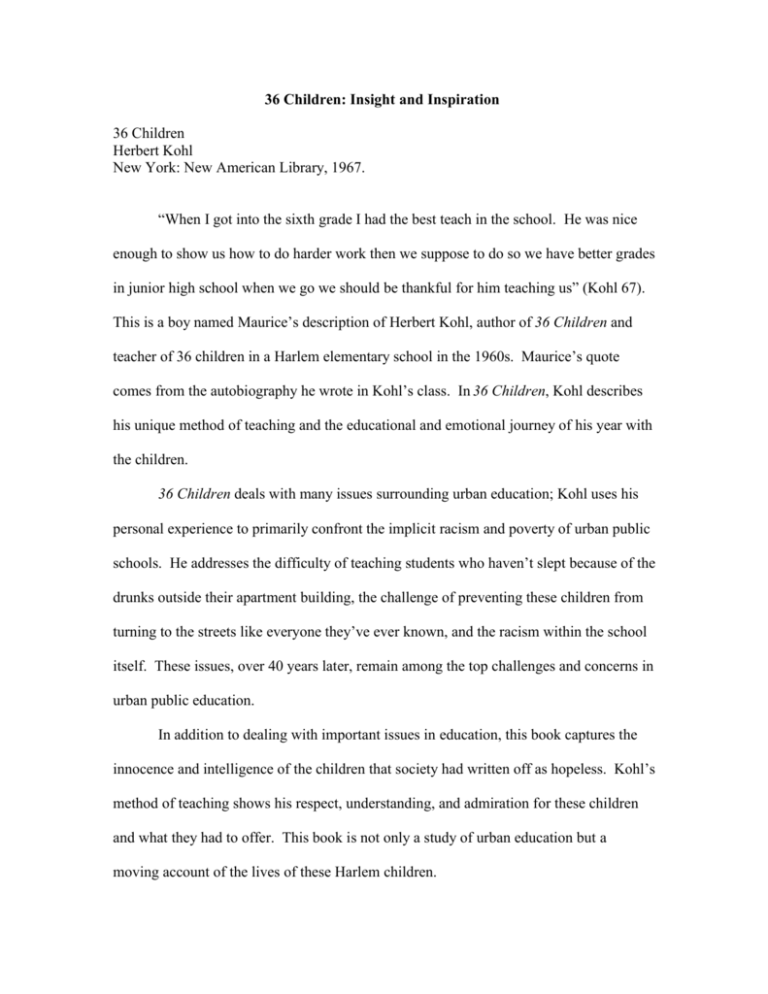36 Children
advertisement

36 Children: Insight and Inspiration 36 Children Herbert Kohl New York: New American Library, 1967. “When I got into the sixth grade I had the best teach in the school. He was nice enough to show us how to do harder work then we suppose to do so we have better grades in junior high school when we go we should be thankful for him teaching us” (Kohl 67). This is a boy named Maurice’s description of Herbert Kohl, author of 36 Children and teacher of 36 children in a Harlem elementary school in the 1960s. Maurice’s quote comes from the autobiography he wrote in Kohl’s class. In 36 Children, Kohl describes his unique method of teaching and the educational and emotional journey of his year with the children. 36 Children deals with many issues surrounding urban education; Kohl uses his personal experience to primarily confront the implicit racism and poverty of urban public schools. He addresses the difficulty of teaching students who haven’t slept because of the drunks outside their apartment building, the challenge of preventing these children from turning to the streets like everyone they’ve ever known, and the racism within the school itself. These issues, over 40 years later, remain among the top challenges and concerns in urban public education. In addition to dealing with important issues in education, this book captures the innocence and intelligence of the children that society had written off as hopeless. Kohl’s method of teaching shows his respect, understanding, and admiration for these children and what they had to offer. This book is not only a study of urban education but a moving account of the lives of these Harlem children. Herbert Kohl is both a teacher and a writer. At the start of his first year in Harlem, he was still young but not inexperienced. However, his prior teaching experiences had been primarily with white privileged students. His primary purpose in 36 Children is to show both the skills and the needs of urban schoolchildren; he displays their amazing skill, passion, and potential, but also reveals their weaknesses—their hunger for emotional relationships and connections, especially with adults. He also points out the shortcomings of what the elementary school did for the children and the general inadequacy of conventional methods of education, especially for urban children. Kohl accomplishes his goal effectively by using primary sources. Not only does Kohl describe the children and the day-to-day events that took place, but he includes actual examples of the children’s writings, drawings, and poems. He writes the majority of the text in a personal narrative, going thematically (and, for the most part, chronologically) through the school year. The final section of the book tells of his and the children’s experience in the following years. Kohl begins the book by describing his intimidation and idealism on the first day of class. He tells of his refusal to read the cards with preconceived descriptions of each child, and how he shocked the children by asking them what they wanted to learn. After an initial tenuous and mutually fearful beginning, the children gradually began to reveal their dire living and family conditions. This gives Kohl the idea to help the children face the streets that they come from and to use school to help them explore their own feelings about their lives. Kohl stumbled upon this exploration method somewhat accidentally. The children would get sluggish, quiet, and bored during traditional lessons, they were apathetic towards books that were technically too difficult for them. One day, after a child used the word “psychs” as a derogatory nickname to another child, Kohl started a discussion about language, the meaning of words, and Greek mythology. His was able to connect academics to something the children cared about. This sparked their interest. “The class became word-hungry and concept-hungry, concerned with discovering the ‘right’ word to use at a given time to express a specific thought” (Kohl 36). Kohl started giving the children free time to draw, write, talk, or play games. “Fear is only overcome through risk and experimentation” (Kohl 31). This was how the class stumbled upon writing, an activity that they would remain passionate about throughout the year. Their interest in Greek mythology lead some of them to write adventure stories; for others, writing became a self-exploratory action, such as Maurice’s autobiography. Writing allowed the children to deal with their lives in a way they were afraid to before. Maurice’s autobiography begins with the warning: “It will tell you how he lived and how he liked it or disliked it. It will tell you how important he was and happy or sad he was in this world it will tell you all his thoughts. It may be pleasant and it may be horrible in place but what ever it is it will be good and exciting but! their will be horrible parts. This story will be made simple and easy but it places hard to understand. This is a nonfiction book” (64). As the year progressed, the children’s writing grew from paragraphs describing the junkies on their block to poetry, fables, and chapter books with illustrations. They became so passionate about writing that they started a literary magazine called And. Since Kohl’s method was to allow the children to freely express themselves without being limited or intimidated by technical rules, And was less polished than other school magazines, more harsh and honest, and consequently more dark and violent. When the school’s only response was to give the children a proof-reading lesson, Kohl and the children grew discouraged but not defeated. After a year of watching the students grow personally and academically, Kohl still feared that the upcoming placement tests would not recognize the intelligence of the children. Public schools continue to face this problem today. Standardized tests claim to measure intelligence while disregarding any emotional or non-traditional intellectual growth children make (Noguera 15). Kohl spent the last part of the year preparing them to pass the junior high placement tests. He writes, “The children learned that they could do unpleasant but necessary work; they also knew that the test preparation was not all there was to education, that the substance of their work, the novels and stories, the poems and projects they created, were the essential thing no matter how the external world chose to judge them” (Kohl 178). The final part of the book, “A Dream Deferred,” discusses the years following his year with the 36 children. As he taught a new class and his old students kept returning, he realized what he had given them, despite their continuing troubles: “The reason so many kids come back to visit is not because of what I taught—they forget that—but because at one time they were safe here, protected from the indifference and cruelty of the system. They can talk to me of their failure and despair—unfortunately I understand it” (188). Despite the fact that most of the children remained in contact with Kohl, many of them could not fight what Kohl describes as the pull of the streets. Kohl effectively combines personal, emotional narrative with objective observations about urban education. He integrates his own learning experiences with his description of the children and classroom events. His inclusion of actual writings from his students strengthens his message and powerfully conveys both the children’s plight and potential. Rather than telling of his experience, he shows the deeply personal work of the children, which accomplishes his purpose of conveying both the hope and despair that existed in his Harlem classroom. In order to accomplish his more specific goal of addressing the shortcomings of the school, Kohl points out the lack of communication and trust, not to mention resources, that was present in the school. Kohl fought two issues that remain common in urban public schools—a lack of resources as well as a mindset of hopelessness (Noguera 16). The administration denies his classroom enough books or even level-appropriate books, science equipment, and discourages the creativity and honesty of And. This, combined with his description of the system’s closed-minded categorization of the children, effectively proves the mistrust and apathy of the administration towards the children, personally and symbolically. Kohl also sharply, though somewhat indirectly, criticizes conventional teaching methods. He clearly connects his initial exasperation and failure with the children to his rigidity and adherence to structure, as well as his own fear to deviate from a traditional classroom structure. As soon as he gives the children freedom and shows his confidence in them, their relationship and their performance begins to change, and Kohl makes a strong case advocating his teaching style by showing this connection. Kohl’s success contributes greatly to the prospects and hope of improving the quality of urban education and the lives of its children. His unconventional approach yielded encouraging results. In his first year at the school, he was able to touch the life of every disadvantaged, apathetic, underestimated student in his overcrowded classroom. And although Kohl readily admits his inability to ensure future success for every student, the impact he does have only reinforces the importance of personally reaching out to impoverished children and becoming a lasting, long-term figure in their lives. Kohl’s story advocates more personal, exploratory teaching methods and the need to connect with children’s outside lives to prevent them from turning to the streets. His primary contributions to improving urban public education include both the importance of writing for personal and academic growth, and a demonstration of the societal need to help children living in impoverished conditions outside of just school. 36 Children remains relevant over 40 years later in this era of standardized testing, impersonal schools, and mistrust. Kohl conveys his message effectively through his emotional yet informative account of his experience. His depiction of his own learning process as the year progresses establishes the egalitarian relationships and setting of his classroom. His inclusion of so many student writings also reveals his deep respect and admiration for the children, which strengthens his points about mutual trust and respect. The student writings are also extremely effective in emotionally engaging and educating his audience. Alvin’s “A Boy in the Slums” is an example of the students’ moving writing—a personal story that pleas for an end to segregation and poverty. It also shows Kohl’s learning and admiration for the children, and the sadness of their future. Kohl prefaces Alvin’s story with: “In support of my effort to reach as much of the truth of my classroom as I can, the best witness I can call is Alvin—not Alvin today who remembers very little of 6-1, has no time for memories in the burden and torture of his present. I have to call on Alvin the author, whose The Boy in the Slums has shown me something of myself and the class through the sensitive alien eyes of a child” (138). One of 36 Children’s greatest strength is exactly what this quote demonstrates: Kohl’s ongoing personal struggle and growth to become a better teacher by personally connecting with the children. “Teachers ought to attempt to do the writing assignments they give before deciding upon criteria to judge children’s efforts,” he writes. “What would happen to the grading of children’s poetry if teachers used examples of their own work instead of Robert Frost or Walt Whitman as models for grading?” (136). Throughout the book, statements like this show his honest effort to be an advocate for the children, to praise the quality of their ideas rather than criticize their technical shortcomings. Another one of Kohl’s themes, an issue he struggles with throughout the book, is the question of how personally involved it is “appropriate” to get in the children’s lives. “The principal and other teachers had warned us about getting too friendly with the children, of transcending the traditional formal distance between pupil and teacher. They told me it wasn’t ‘professional’ to develop relationships with the children outside the context of school. Besides, one of the older teachers had warned me, ‘You never can tell what ‘these’ children might do’… No, I couldn’t tell, but the children couldn’t tell about me either. That was our greatest problem: we didn’t know each other’s lives” (103). Kohl proves, especially in the last section of the book, that relationships outside of school are exactly what will save troubled children. The trust they developed and the communication they established allowed Kohl to be a force in these children’s lives after they left his classroom, which was when they needed him the most. Kohl’s moving account of his experience with the children, along with his original and important contributions, make 36 Children an effectively written critique of impersonal, traditional methods of teaching and an inspiring message of hope for impoverished children and schools. By focusing on writing as the children’s tool to express and discover themselves, Kohl suggests a more effective approach to teaching as well as shows the talent and honesty of his children. 36 Children is a beautifully written account of urban education that has the potential to both educate and inspire.






